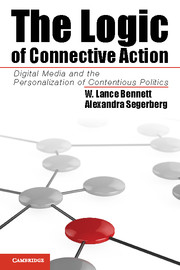Book contents
- Frontmatter
- Contents
- List of Tables and Figures
- Acknowledgments
- Introduction
- 1 The Logic of Connective Action
- 2 Personalized Communication in Protest Networks
- 3 Digital Media and the Organization of Connective Action
- 4 How Organizationally Enabled Networks Engage Publics
- 5 Networks, Power, and Political Outcomes
- 6 Conclusion
- Bibliography
- Index
1 - The Logic of Connective Action
Published online by Cambridge University Press: 05 June 2014
- Frontmatter
- Contents
- List of Tables and Figures
- Acknowledgments
- Introduction
- 1 The Logic of Connective Action
- 2 Personalized Communication in Protest Networks
- 3 Digital Media and the Organization of Connective Action
- 4 How Organizationally Enabled Networks Engage Publics
- 5 Networks, Power, and Political Outcomes
- 6 Conclusion
- Bibliography
- Index
Summary
With the world economy in crisis, the heads of the 20 leading economies held a series of meetings beginning in the fall of 2008 to coordinate financial rescue policies. Wherever the G20 leaders met, whether in Washington, London, St. Andrews, Pittsburgh, Toronto, or Seoul, they were greeted by protests. London was the scene of nearly a week of coordinated events scheduled on different days to accommodate activists of various political stripes. The largest of these demonstrations was sponsored by a number of prominent NGOs, including Oxfam, Friends of the Earth, Save the Children, and World Vision. This loose coalition launched a campaign called “Put People First” (PPF), promoting public mobilization against the social and environmental harms they felt would result from “business as usual” solutions to the financial crisis. The website for the campaign carried the simple statement:
Even before the banking collapse, the world suffered poverty, inequality and the threat of climate chaos. The world has followed a financial model that has created an economy fuelled by ever-increasing debt, both financial and environmental. Our future depends on creating an economy based on fair distribution of wealth, decent jobs for all and a low carbon future. (Put People First 2009)
- Type
- Chapter
- Information
- The Logic of Connective ActionDigital Media and the Personalization of Contentious Politics, pp. 19 - 54Publisher: Cambridge University PressPrint publication year: 2013
- 6
- Cited by



